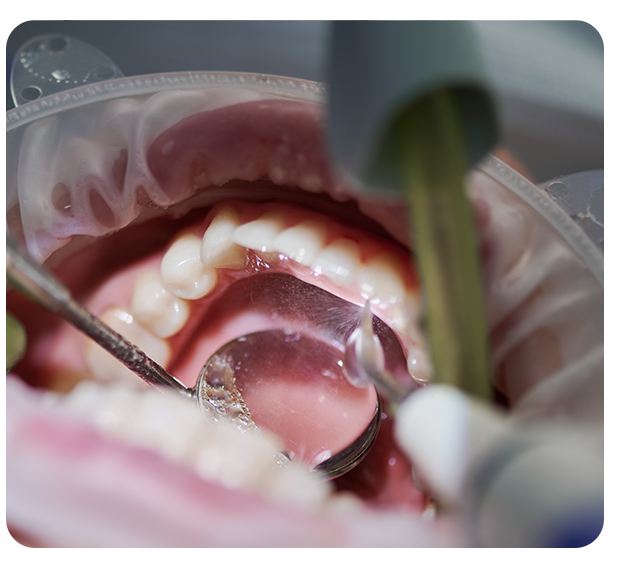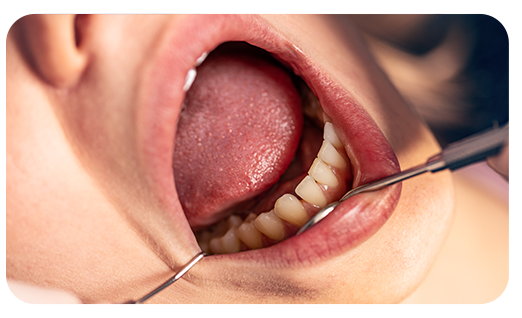Gum Recession Treatment
Gum recession is a serious oral health issue that many people face but often neglect. It can expose the tooth roots, leading to sensitivity, aesthetic concerns, and even tooth loss. However, having the right knowledge and applying proper treatment methods can prevent this problem. At LHC Clinic, we explore the causes, symptoms, and effective treatments for gum recession in this comprehensive guide.

What Causes Gum Recession?
There are several factors that contribute to gum recession. The primary causes include:
- Gum Diseases: Periodontal diseases and gingival infections can lead to gum recession.
- Improper Brushing Techniques: Using a hard-bristled toothbrush or applying excessive pressure while brushing can harm the gums.
- Genetic Factors: Family history can increase the likelihood of gum recession.
- Teeth Grinding and Clenching (Bruxism): Grinding your teeth at night or due to stress can contribute to gum recession.
- Poor Oral Hygiene: Neglecting regular brushing and flossing can promote bacterial growth and infections.
- Tartar Buildup: Dental tartar can advance beneath the gums, leading to recession.
- Smoking and Tobacco Use: Smoking negatively affects gum health, contributing to recession.
- Improper Dental Treatments: Faulty fillings or crowns can damage the gums.
- Dietary Habits: Excessive sugary and acidic foods can weaken tooth enamel, affecting gum health.
- Hormonal Changes: Pregnancy, menopause, and puberty can make gums more sensitive.
What Are the Symptoms of Gum Recession?
⚠️ Symptoms of Gum Recession
Gum recession usually progresses slowly, making it difficult to detect at first. However, the following signs should not be overlooked:
- Increased tooth sensitivity
- Teeth appearing longer than usual
- Gum bleeding and swelling
- Bad breath or an unpleasant taste in the mouth
- Change in gum color (paleness or redness)
- Formation of pockets due to gum recession
If any of these symptoms are noticed, it’s important to visit a dentist promptly.


Treatment Methods for Gum Recession
🦷 Treatment Options for Gum Recession
Treatment for gum recession depends on the severity of the condition and the underlying causes. Common treatment options include:
- Professional Teeth Cleaning (Scaling): Dentists can remove plaque and tartar buildup to maintain gum health. This can prevent the progression of recession.
- Root Surface Smoothing (Curettage): By smoothing rough surfaces on the tooth roots, bacteria accumulation is prevented, and gum tissue healing is supported.
- Laser Treatment: Laser technology is a less invasive method that accelerates tissue healing and can be used to treat gum diseases.
- Gum Grafting (Tissue Transplant): In advanced cases of gum recession, healthy tissue from the patient’s mouth is used to regenerate the gum area.
- Pink Aesthetic Procedures: Aesthetic issues caused by gum recession can be addressed through laser or surgical methods to restore the smile.
- Night Guards: Special night guards can be used to prevent gum recession caused by bruxism.
- Antibiotic Treatment: For gum infections, a dentist may prescribe antibiotics to prevent further recession.
- Natural and Herbal Remedies: Aloe vera, coconut oil pulling, and saltwater rinses can help support gum health. However, these should complement professional treatment rather than replace it.
How to Prevent Gum Recession?
🛡️ How to Prevent Gum Recession
To prevent gum recession, regular oral care is essential:
- 🪥 Brush your teeth gently at least twice a day with a soft-bristled toothbrush.
- 🧵 Use dental floss and mouthwash to maintain good oral hygiene.
- 🚭 Avoid smoking and tobacco products.
- 🦷 Visit your dentist regularly for check-ups.
- 🍊 Consume foods rich in vitamin C.
- 🥜 Avoid hard and abrasive foods.
- 😌 Manage stress to prevent teeth grinding.
- 💧 Stay hydrated to maintain oral moisture balance.


Conclusion Gum Recession
🏥 Protect Your Gums with Expert Care at LHC Clinic
Gum recession can be managed with early detection and the right treatment methods. If you notice any symptoms, don’t delay in consulting with a dentist. Healthy gums are not only essential for an aesthetic smile but also play a critical role in your overall health.
At LHC Clinic, we offer the most effective treatment solutions with our expert dental team to protect your gum health. Don’t neglect your regular dental care for a healthier mouth!
Frequently Asked Questions
Missing teeth can lead to:
• Shifting of adjacent teeth, causing bite problems
• Bone loss in the jaw over time
• Speech difficulties and chewing inefficiency
• Psychological effects, such as lowered self-esteem
Timely replacement with suitable dental prostheses can prevent these complications.
Teeth Grinding Habit: Its Relation to Stress and Solutions Teeth grinding, or bruxism, is closely linked to stress, anxiety, and tension. Solutions include: • Using a night guard • Stress-reduction practices (yoga, therapy, exercise) • Mindfulness techniques to become aware of daytime clenching Addressing the root causes of stress can significantly reduce grinding episodes.
Why Are Color, Shape, and Symmetry Harmony Important in Dental Aesthetics? In smile design, achieving harmony in color, shape, and symmetry is key to creating a natural, balanced appearance. Discrepancies can make even healthy teeth look unattractive. Factors considered: • Matching the veneers or crowns to the natural tooth color and shape • Ensuring proportionate tooth sizes relative to facial features • Aligning teeth for overall symmetry This careful planning ensures the smile enhances the patient’s overall facial aesthetics.
Early gum disease (gingivitis) is often painless but presents signs such as:
• Red, swollen, or tender gums
• Bleeding when brushing or flossing
• Chronic bad breath
• Receding gums or tooth sensitivityRecognizing these early warnings can prevent progression to more serious conditions like
periodontitis, which may lead to tooth loss.
Diastema is the space between two teeth, commonly affecting the upper front teeth.
Treatment options include:
• Composite bonding for quick aesthetic correction
• Porcelain laminates for larger gaps
The best approach depends on the size of the gap, aesthetic goals, and oral health status.
